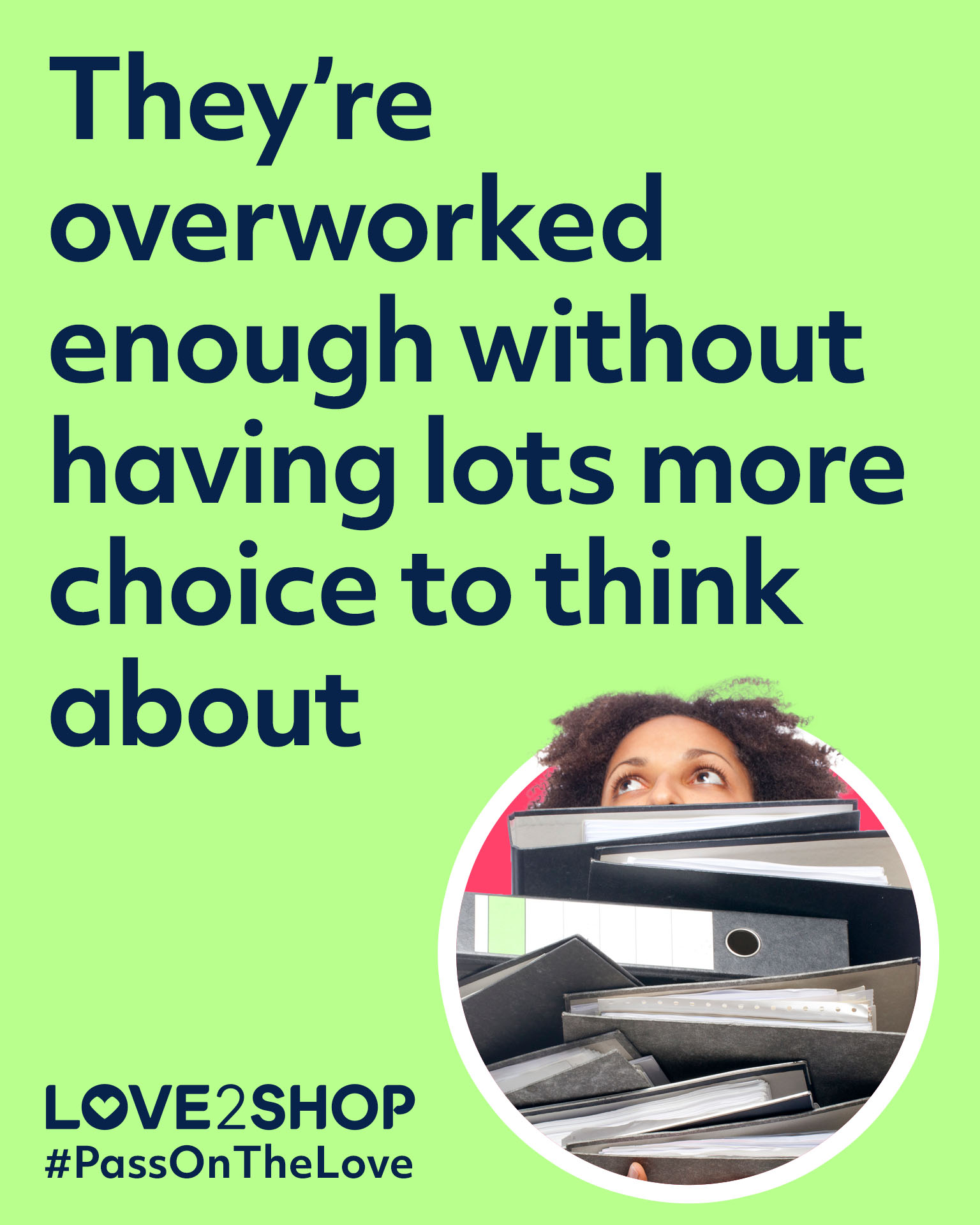10 reasons NOT to give staff Love2shop this Christmas
Irritating music in every shop, glitter covering every surface and staff clamouring for time off and early finishes.
Christmas is coming – and don’t we know it. If your business wants the season of giving to be given the big heave-ho, you probably don’t plan to give your team any gifts or rewards this Yuletide season. Or maybe you think they get enough from you already, so plan to give them all something super-cheap so you’re not seen as a total Grinch?
Here at Love2shop, we want to help, so we’ve put together a list of top reasons to NOT give your team gifts or bonuses this year.

1. You fancy bit of Christmas party drama
Everyone loves a moan over Christmas drinks, so make sure you’re the one they’re all talking about by giving everyone something cheap and nasty – or even nothing at all.
The top reason for UK workers feeling undervalued according to the 2023 Love2shop Employee Value Report was that their contribution to the business was not acknowledged.
So give the gift of gossip and make tongues wag as your staff give you a proper bashing behind your back at their Christmas party for being miserable and ignoring them. Don’t worry, you won’t hear it as you’re probably not invited!

2. You secretly adore being called a Scrooge
We all have our idols – those who inspire us. Despite business podcasts not being invented at the time, Ebenezer Scrooge is a name that has still managed to stand the test of time so he must have been on to something, right?
Pinching pennies from employees already struggling with the cost of living is guaranteed to secure your place in infamy – and could end up costing you more in recruitment and training costs when your staff leave.
If you do want to avoid the Ghost of Christmas Present(s), pass on the love instead with the gift of choice – a Love2shop Gift Card, e-Gift Card or voucher.

3. You love giving money to the taxman totally unnecessarily
Who is disliked more than a terrible boss? That’s right, the taxman! The bad guys need to stick together though so if you are going to give bonuses or gifts to staff, at least doing it through payroll means you pay full tax on it.
If you give an employee a £50 gift as a direct payment for example, you could pay up to £48.10 on top of that in tax and National Insurance, meaning your £50 gift will cost your business almost £100 per employee.
If you don’t like the idea of your business paying more tax however then HMRC’s Trivial Benefits provision allows you to give gifts, including Love2shop Gift Cards, e-Gift Cards and vouchers – up to the value of £50 per employee tax-free.
If you like the idea of your business paying more tax you definitely should NOT use Love2shop’s Tax-Free Gift Calculator. It shows you how much you could save by giving gifts using Love2shop Gift Cards, e-Gift Cards and vouchers instead of direct payments.

4. They already get enough benefits (like 20 days’ holiday and paid toilet breaks)
We all know the struggle – trying to juggle team members who expect time off to spend with their families and actually use all their annual leave. It’s almost as if they are never there. When they are, we don’t even stop paying them when they take a loo break!
So why should we give them more? Spontaneous gifts are proven to increase productivity – according to the Love2shop Employee Value Report 90% of UK workers would feel more valued if they received a gift card from their employer and happy workers are 13% more productive.
In other words, avoid gifting if you want a team that just turns up and goes through the motions.

5. You love naff staff gifts
What’s better than watching a team member opening a gift from you, then seeing the crushing disappointment as they realise you’ve bought a job-lot from the local discount store?
Spending time understanding each employee is a full-time job and who has time for that? Give naff gifts and let them show their gratitude by updating their LinkedIn profiles and CVs and leading a New Year exodus of staff.
It’s not as if someone has invented a product that can be given tax-free (up to £50) that gives individuals the ability to choose a gift they really want. (Spoiler – they have, it’s Love2shop).

6. To discourage your staff from shopping online during worktime
Do your staff ever look online at social media or shopping sites during work? Of course not, because you are a master of industry who commands respect – they spend every single minute toiling away at their station with barely a break, right?
Surely a gift that could help ease their money worries and help them focus on work is pure fantasy. A gesture that helps stop them being so anxious to find bargains that they spend every spare minute searching the internet for deals?
As well as Love2shop’s gift cards and vouchers, we also offer the Everyday Benefits Card. For a relatively small fee, you can provide these cards to your staff. They can pre-load them with funds at a 7.5% discount to save money on high street and online spending. And they can keep using it long after Christmas.

7. You don’t want people getting too choosy. In case they choose another job
Gift giving is a double-edged sword. Give them something good and they’ll expect better next time. In the end you’ll fall short and they’ll look for another job, so why not avoid all that hassle and lower expectations instead?
If setting the bar low doesn’t work for your customers, it won’t work for your employees either. Increased productivity and revenue from motivated staff should more than cover the cost of festive giving each year. Then again, what do we know, we’ve only been doing this for decades.

8. You’d sooner get them something motivational (like an alarm clock)
Creating a hustle culture is what matters. Going to bed at 5am, getting up at 4am to create a 25-hour day instead of 24 like all those other losers – that’s how to get ahead.
Being such a motivational leader feeds into everything you do and you need to pass that on to your team. Turn gift giving into an opportunity to show people what they need to do to improve – whether that’s buying them an alarm clock to get them up earlier or a duvet to wrap themselves up in at their desk so they never have to go home.
Alternatively give them the freedom to choose. With Love2shop’s range of flexible gifting options, they can choose their own path and you can maybe just chill a little…

9. They might pull a sickie to go shopping
Let’s play devil’s advocate. You are generous and give your staff Love2shop gifts this Christmas. But when will they spend them? Of course it won’t be during the evenings or weekends, and certainly not on any annual leave days. No, they are most likely to pull a sickie and call in with ‘flu’ or a stomach bug so they can go on a mini spending spree.
Yeah, it doesn’t sound right to us either, because that’s not generally what people do. Trust and loyalty are a two-way street, but the Love2shop Employee Value Report found that 29% of UK workers felt loyalty was a one-way street with employers not supporting them.
Why not show your workforce a bit of trust? Make them feel appreciated and you’ll see the benefits.

10. They’re overworked enough without having lots more choice to think about
None of our previous tips are relevant to you as you are a benevolent, kind boss. You don’t give staff Christmas gifts, it’s true. But only because you don’t want to burden your poor employees with any extra worry.
They have so much to do, giving them something like Love2shop, which offers them so much choice, will simply be too much for them to cope with.
How will they be able to concentrate on the upcoming fiscal reports or correctly filling out the warehouse dispatch forms when they are bamboozled by where to spend their Christmas gift card? Usually they think about nothing but work during their shift, don’t they?
We’re sure that if this last point even remotely resonates with you, your HR department must be putting in overtime to deal with unhappy employees.
Much of what distracts and stresses your staff is either financial worry, frustration at a lack of acknowledgement or a sense they are not valued by the business.
Gifting at Christmas is an easy way to start to change this mindset and giving gifts that offer them choice can ease those financial concerns at a pretty expensive time of year.
Time to confess…
If you’ve got this far into the article and still feel like gifting employees at Christmas is a waste of time and money, sorry, but our tongue was firmly in our cheek on this one.
The truth is – and the data supports this – gifting employees at any time of year boosts happiness, productivity and loyalty.
At Christmas, when people are feeling their budgets squeezed even more, the effect is much greater.
Put away the Grinch suit and embrace gifting your staff this Christmas. It’ll be the best gift your business could receive.
Contact our team here today to discuss how you can get your Love2shop gifts delivered in time for Christmas 2023 or visit our self-serve portal and get started yourself here.









